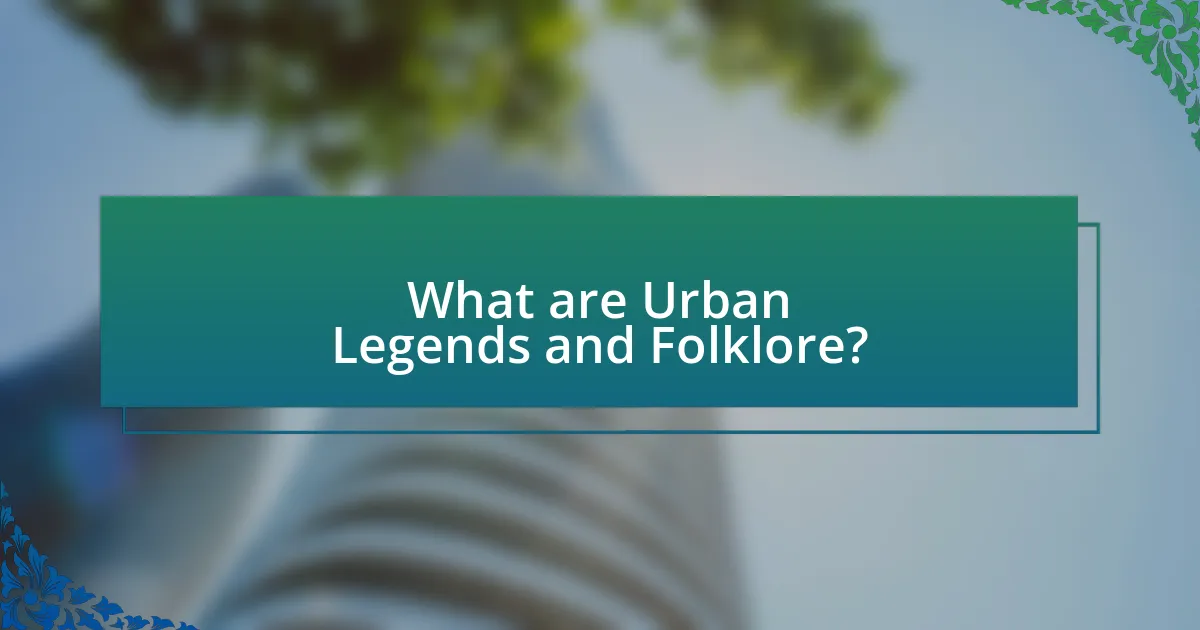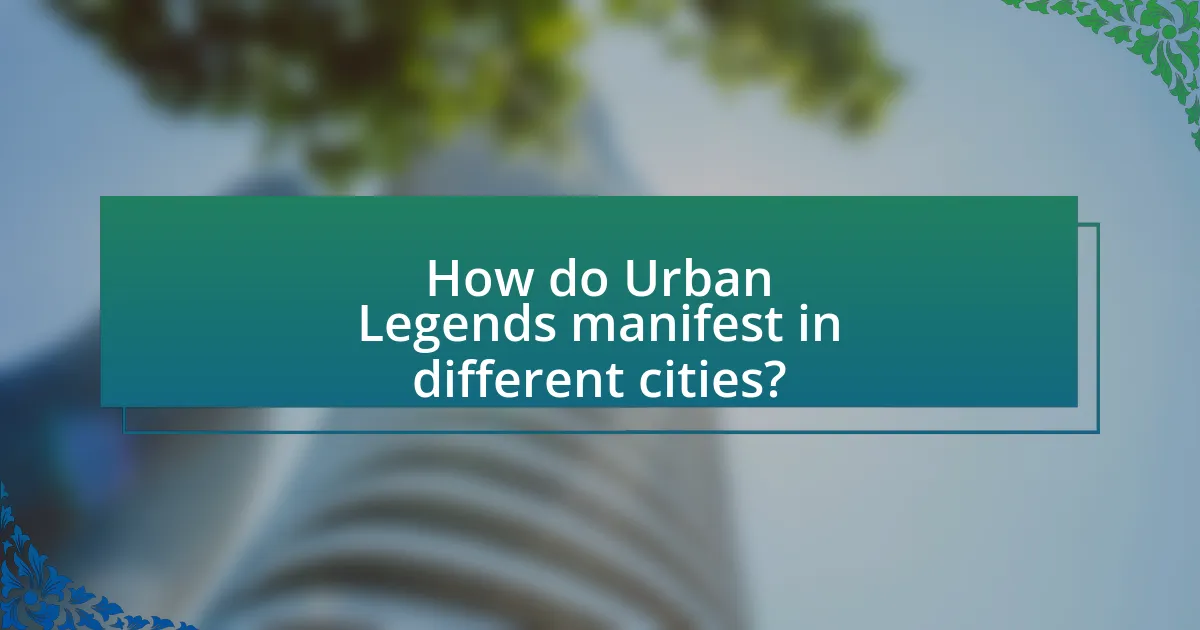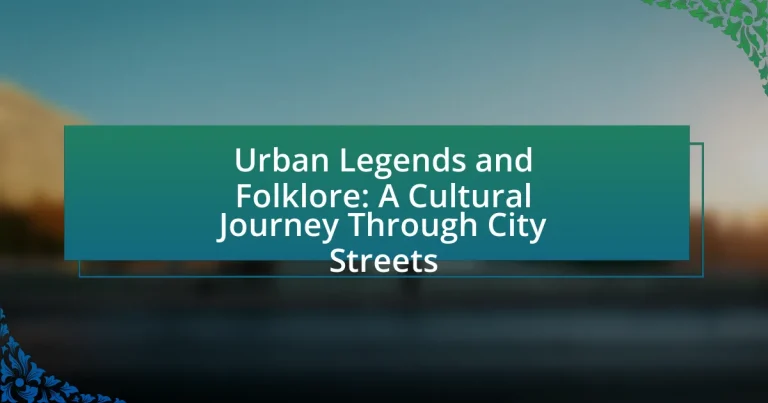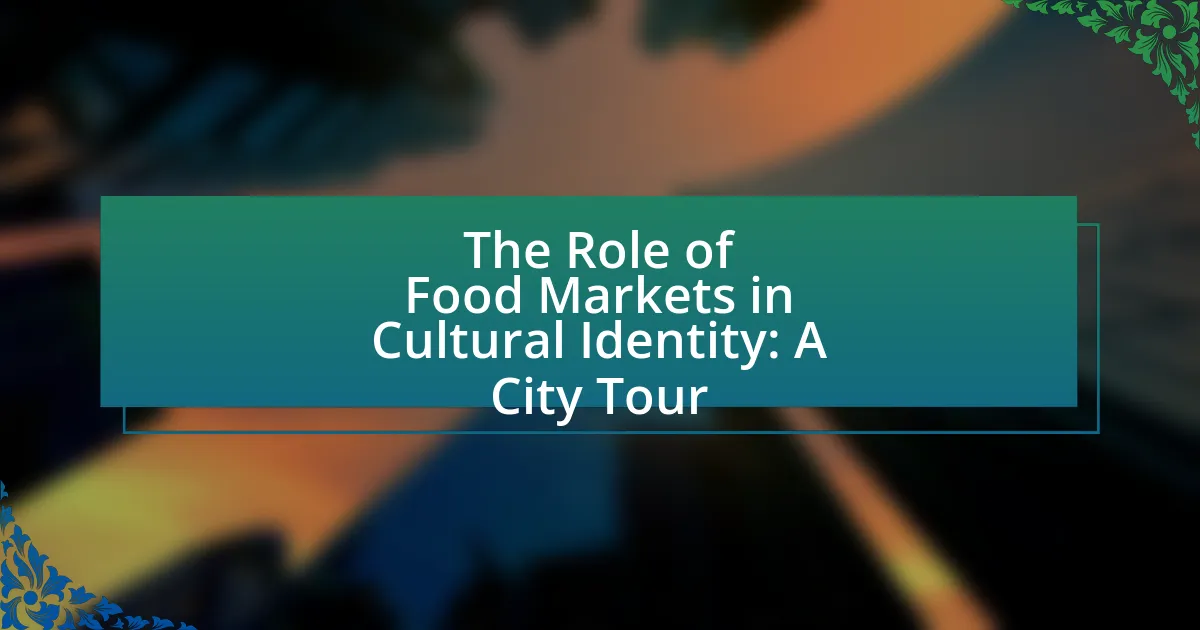Urban legends and folklore are integral components of cultural identity, reflecting societal values, fears, and collective experiences. Urban legends, characterized by their sensational narratives and moral lessons, differ from traditional folklore in their contemporary context and transmission methods. This article explores the evolution of urban legends within urban settings, their psychological effects, and their role in shaping community identity. It also examines how local cultures influence the creation of these legends, the common themes they share, and the implications of believing in them, including the potential for misinformation and panic. Additionally, practical strategies for critically evaluating and debunking harmful urban legends are discussed, emphasizing the importance of cultural narratives in fostering social cohesion and understanding.

What are Urban Legends and Folklore?
Urban legends are modern myths or stories that circulate within a culture, often conveying a moral lesson or warning, while folklore encompasses traditional beliefs, customs, and stories passed down through generations. Urban legends typically involve sensational or supernatural elements and are often presented as true, despite lacking verifiable evidence. For example, the story of a killer hiding in the backseat of a car serves as a cautionary tale about safety. Folklore, on the other hand, includes a broader range of cultural expressions, such as fairy tales, songs, and proverbs, reflecting the values and experiences of a community. Both urban legends and folklore play significant roles in shaping cultural identity and social norms.
How do Urban Legends differ from traditional Folklore?
Urban legends differ from traditional folklore primarily in their contemporary context and the nature of their transmission. Urban legends are modern myths that often reflect societal fears or anxieties, typically spread through word of mouth, social media, or urban settings, while traditional folklore encompasses older, culturally rooted stories passed down through generations, often tied to specific communities or regions. For example, urban legends like “the killer in the backseat” resonate with modern fears about safety and technology, whereas traditional folklore, such as fairy tales or myths, often convey moral lessons or cultural values from a historical perspective. This distinction highlights how urban legends adapt to current societal issues, whereas traditional folklore remains anchored in historical and cultural contexts.
What are the key characteristics of Urban Legends?
Urban legends are characterized by their anecdotal nature, often featuring sensational or shocking elements that evoke fear or intrigue. These narratives typically circulate informally, gaining traction through word-of-mouth and social media, which contributes to their evolving nature. Additionally, urban legends often contain a moral lesson or cautionary tale, reflecting societal fears or cultural values. Their persistence in popular culture is evidenced by their adaptability to contemporary contexts, as seen in the adaptation of classic legends to modern settings, such as the “killer in the backseat” story.
How does Folklore evolve in urban settings?
Folklore evolves in urban settings through the adaptation of traditional narratives to contemporary contexts and the influence of diverse cultural interactions. Urban environments facilitate the blending of various cultural backgrounds, leading to the creation of new urban legends that reflect current societal issues, technological advancements, and local experiences. For example, the rise of social media has transformed the dissemination of urban legends, allowing stories to spread rapidly and evolve in real-time, as seen in the viral nature of urban myths like the “killer in the backseat” narrative. This evolution is further evidenced by the incorporation of local landmarks and contemporary figures into folklore, making it relevant to the urban populace and enhancing community identity.
Why are Urban Legends important to cultural identity?
Urban legends are important to cultural identity because they serve as a reflection of societal values, fears, and collective experiences. These narratives often encapsulate the beliefs and norms of a community, allowing individuals to connect with their cultural heritage. For instance, urban legends can highlight local issues, such as crime or social justice, thereby fostering a sense of belonging and shared understanding among community members. Additionally, studies have shown that urban legends can reinforce group identity by providing a common narrative that is passed down through generations, thus preserving cultural continuity.
How do Urban Legends reflect societal fears and values?
Urban legends reflect societal fears and values by encapsulating collective anxieties and moral lessons relevant to specific cultural contexts. These narratives often emerge in response to social changes, technological advancements, or cultural shifts, illustrating what communities find threatening or morally significant. For example, urban legends about dangerous strangers or toxic substances highlight societal fears regarding safety and trust in others, while tales of supernatural occurrences may reflect deeper existential concerns or the need for community cohesion. Research indicates that urban legends serve as a means of social commentary, reinforcing shared values and norms while simultaneously addressing underlying fears, as seen in studies by folklorists like Jan Harold Brunvand, who documented how these stories evolve to mirror contemporary issues.
What role does storytelling play in preserving Folklore?
Storytelling plays a crucial role in preserving folklore by serving as the primary medium through which cultural narratives, traditions, and values are transmitted across generations. This oral tradition ensures that the stories, which often reflect the beliefs and experiences of a community, remain alive and relevant. For instance, studies have shown that communities that actively engage in storytelling practices are more likely to maintain their cultural identity and heritage, as these narratives encapsulate historical events, moral lessons, and social norms. By recounting tales of urban legends and folklore, individuals reinforce communal bonds and foster a shared understanding of their cultural landscape, thereby safeguarding these narratives against the erosion of time and modernization.

How do Urban Legends manifest in different cities?
Urban legends manifest in different cities through localized narratives that reflect the cultural, social, and historical contexts of those areas. For instance, in New York City, the legend of the “New York City Subway Alligators” illustrates urban fears and the mythologizing of the underground environment, while in Los Angeles, the “Black Eyed Children” legend taps into anxieties about safety and the unknown in suburban neighborhoods. These legends often evolve from real events or societal issues, such as crime or urban decay, and are shared through word of mouth, social media, and local folklore gatherings, reinforcing community identity and shared experiences. The specific characteristics of each urban legend are shaped by the unique demographics and cultural narratives of the city, making them distinct yet reflective of broader human concerns.
What are some famous Urban Legends from major cities?
Some famous urban legends from major cities include the “Chupacabra” in Puerto Rico, which is said to be a blood-sucking creature that preys on livestock, and the “Vanishing Hitchhiker” legend prevalent in many cities, where a driver picks up a hitchhiker who mysteriously disappears before reaching their destination. In Chicago, the “Resurrection Mary” tale involves a ghostly woman who haunts a local cemetery and is known for asking for rides. New York City features the “Alligators in the Sewers” myth, suggesting that baby alligators were flushed down toilets and now inhabit the sewer system. Each of these legends reflects local culture and fears, contributing to the folklore of their respective cities.
How do local cultures influence the creation of Urban Legends?
Local cultures significantly influence the creation of urban legends by shaping the themes, characters, and narratives that resonate with community values and fears. For instance, urban legends often reflect local history, social issues, or cultural taboos, making them relevant and relatable to the community. A study by Jan Harold Brunvand, a folklorist, highlights how urban legends serve as a means of social commentary, often addressing contemporary anxieties such as crime or technology, which vary from one culture to another. This contextual relevance ensures that urban legends evolve alongside cultural shifts, reinforcing their role as a reflection of local identity and collective experiences.
What are the common themes found in Urban Legends across cities?
Common themes found in urban legends across cities include fear of the unknown, social anxieties, and moral lessons. These legends often reflect local cultural values and societal concerns, such as crime, technology, and the supernatural. For instance, many urban legends involve cautionary tales about strangers or dangerous situations, highlighting community fears about safety. Additionally, urban legends frequently incorporate elements of humor or absurdity, which serve to entertain while also conveying deeper truths about human behavior and societal norms. The prevalence of these themes can be observed in various studies, such as those conducted by folklorists who analyze the narratives and their implications within specific cultural contexts.
How do Urban Legends spread within communities?
Urban legends spread within communities primarily through word-of-mouth communication and social media platforms. These narratives often resonate with cultural fears or societal norms, making them relatable and memorable. Research indicates that urban legends thrive in environments where individuals share stories in informal settings, such as gatherings or online forums, which facilitates rapid dissemination. For example, a study by the University of California found that urban legends can spread quickly through social networks, with individuals sharing them to reinforce group identity or entertain others. This combination of relatable content and effective communication channels contributes significantly to the persistence and evolution of urban legends within communities.
What mediums are most effective for sharing Urban Legends?
Digital platforms, particularly social media and websites, are the most effective mediums for sharing urban legends. These platforms facilitate rapid dissemination and engagement, allowing stories to reach a wide audience quickly. For instance, a study by the Pew Research Center found that 69% of adults in the U.S. use social media, making it a prime avenue for sharing and amplifying urban legends. Additionally, forums and blogs dedicated to folklore provide spaces for discussion and elaboration, further enhancing the spread of these narratives.
How does social media impact the dissemination of Urban Legends?
Social media significantly accelerates the dissemination of urban legends by providing a rapid and widespread platform for sharing information. The instantaneous nature of social media allows urban legends to reach large audiences quickly, often leading to viral spread. For instance, a study by the Pew Research Center found that 64% of Americans use social media, which facilitates the sharing of stories and rumors, including urban legends, among diverse user groups. Additionally, the interactive features of social media, such as comments and shares, enable users to engage with and modify these legends, further enhancing their reach and evolution. This dynamic environment fosters a culture where urban legends can be continuously adapted and propagated, making social media a crucial factor in their modern dissemination.

What are the psychological effects of Urban Legends?
Urban legends can induce significant psychological effects, including heightened anxiety, fear, and social bonding among individuals. These narratives often exploit common fears and societal anxieties, leading to increased vigilance and caution in daily life. For example, studies have shown that urban legends can reinforce stereotypes and shape perceptions of safety in communities, as individuals may become more wary of certain places or people based on these tales. Additionally, the sharing of urban legends can foster a sense of belonging and community, as people connect over shared stories and experiences, which can enhance social cohesion.
How do Urban Legends influence behavior and decision-making?
Urban legends significantly influence behavior and decision-making by shaping perceptions of risk and social norms. These narratives often evoke strong emotional responses, leading individuals to alter their actions based on fear or caution associated with the legend. For example, the urban legend of “the killer in the backseat” can cause drivers to be excessively vigilant, impacting their driving behavior and decision to travel alone at night. Research indicates that urban legends can reinforce societal values and fears, as seen in studies that show how tales of danger can lead to increased community vigilance and changes in public policy, such as heightened security measures in neighborhoods.
What psychological mechanisms make Urban Legends compelling?
Urban legends are compelling due to psychological mechanisms such as social validation, emotional arousal, and cognitive biases. Social validation occurs when individuals share and believe in these stories, reinforcing their credibility through collective acceptance. Emotional arousal is triggered by the sensational and often frightening nature of urban legends, which captivates attention and enhances memory retention. Cognitive biases, such as the availability heuristic, lead people to overestimate the likelihood of events depicted in these legends because they are memorable and frequently discussed. Research indicates that these mechanisms contribute to the persistence and spread of urban legends, as they resonate with human psychology and social dynamics.
How can Urban Legends create a sense of community or belonging?
Urban legends create a sense of community or belonging by providing shared narratives that foster collective identity among individuals. These stories often reflect local values, fears, and experiences, allowing people to connect over common cultural references. For instance, urban legends like “The Hookman” or “The Killer in the Backseat” resonate with specific societal anxieties, enabling individuals to bond through discussions and retellings of these tales. Research indicates that storytelling, particularly in the form of urban legends, enhances social cohesion by reinforcing group norms and shared beliefs, as evidenced by studies in folklore and cultural anthropology.
What are the implications of believing in Urban Legends?
Believing in urban legends can lead to significant social and psychological implications. These legends often shape collective beliefs and behaviors, influencing how communities perceive safety, trust, and cultural identity. For instance, a study by the University of California found that urban legends can perpetuate fear and anxiety, particularly regarding crime and safety, which can lead to increased social isolation and mistrust among community members. Additionally, belief in these legends can affect decision-making, as individuals may act based on misinformation rather than factual evidence, impacting public policy and community relations.
How can Urban Legends lead to misinformation or panic?
Urban legends can lead to misinformation or panic by spreading exaggerated or false narratives that evoke fear or concern among the public. These stories often circulate through word of mouth and social media, bypassing critical scrutiny and fact-checking. For instance, the urban legend of “killer clowns” in 2016 caused widespread panic across the United States, leading to increased police presence and public anxiety despite a lack of credible evidence supporting the claims. This phenomenon illustrates how urban legends can manipulate emotions and perceptions, resulting in societal unrest and misinformation.
What are the potential benefits of engaging with Urban Legends?
Engaging with urban legends can enhance cultural understanding and community bonding. These narratives often reflect societal values, fears, and humor, providing insight into the collective psyche of a community. For instance, urban legends can serve as a means of social commentary, highlighting issues such as crime or morality, which can foster discussions and awareness among community members. Additionally, sharing these stories can strengthen social ties, as they often involve shared experiences or local history, creating a sense of belonging and identity. Research indicates that storytelling, including urban legends, plays a crucial role in cultural transmission and social cohesion, reinforcing the importance of these narratives in community dynamics.
What practical tips can help individuals navigate Urban Legends?
To navigate urban legends effectively, individuals should verify information through credible sources before accepting it as truth. This involves cross-referencing claims with reputable news outlets, academic studies, or official reports, as urban legends often stem from misinformation or exaggeration. For instance, the urban legend of “killer in the backseat” has been debunked by law enforcement agencies, emphasizing the importance of checking facts. Additionally, discussing urban legends with knowledgeable individuals or experts can provide clarity and context, helping to distinguish between myth and reality. Engaging in critical thinking and skepticism is essential, as many urban legends thrive on emotional responses rather than factual accuracy.
How can one critically evaluate the truth behind an Urban Legend?
To critically evaluate the truth behind an Urban Legend, one should investigate the origins, sources, and variations of the legend. This involves tracing the story back to its earliest known instance, examining credible sources for factual accuracy, and comparing different versions to identify common elements and discrepancies. For example, the legend of “The Killer in the Backseat” has been documented in various forms since the 1960s, with law enforcement reports and urban folklore studies highlighting its evolution and the lack of substantiated cases. By analyzing these aspects, one can discern the likelihood of the legend being based on real events or purely fictional narratives.
What strategies can be used to debunk harmful Urban Legends?
To debunk harmful urban legends, one effective strategy is to provide factual evidence that contradicts the claims made by the legend. This can involve researching credible sources such as academic studies, expert opinions, or historical records that clarify the truth. For instance, the urban legend about the “killer in the backseat” can be debunked by referencing statistics from law enforcement agencies that show such incidents are extremely rare. Additionally, utilizing fact-checking websites like Snopes or FactCheck.org can help verify the accuracy of claims and provide clear explanations. Engaging in community discussions and educating others about the origins and inaccuracies of these legends can further diminish their spread and impact.


![Food Festivals in [City Name]: Celebrating Local Flavors](https://cityofleadville.com/wp-content/uploads/Featured-image-Food-Festivals-in-City-Name-Celebrating-Local-Flavors-150x150.webp)

